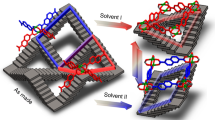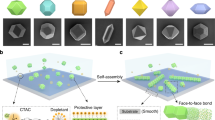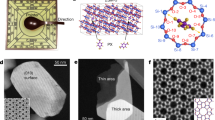Abstract
The ability of porous coordination polymers to undergo reversible structural transformations in response to the presence of guest molecules has been intensively investigated for applications such as molecular separation, storage, sensing and signalling processes. Here we report on the direct observation of the highly guest-responsive nature of the surface of a single-crystalline porous coordination polymer, which consists of paddlewheel zinc clusters and two types of ligand, by in situ liquid-phase atomic force microscopy. Observations were carried out in solution at constant temperature (28 °C) by high-speed atomic force microscopy with lattice resolution. A sharp and reversible response to the presence or absence of biphenyl guest molecules was observed, under conditions that can scarcely induce the transformation of the bulk crystal. Additionally, by modulating the surface coordination equilibrium, layer-by-layer delamination events were captured in real time at every ~13 s per frame.
This is a preview of subscription content, access via your institution
Access options
Access Nature and 54 other Nature Portfolio journals
Get Nature+, our best-value online-access subscription
$29.99 / 30 days
cancel any time
Subscribe to this journal
Receive 12 print issues and online access
$259.00 per year
only $21.58 per issue
Buy this article
- Purchase on Springer Link
- Instant access to full article PDF
Prices may be subject to local taxes which are calculated during checkout






Similar content being viewed by others
Data availability
Crystallographic data for PCP 1 at different temperatures have been deposited at the Cambridge Crystallographic Data Centre, under deposition nos. CCDC 1864180 (10 °C), 1864181 (20 °C) and 1864182 (28 °C). Copies of the data can be obtained free of charge via www.ccdc.cam.ac.uk/data_request/cif. All other data supporting the findings of this study are available within the Article and its Supplementary Information, or from the corresponding author upon reasonable request.
References
Kitagawa, S., Kitaura, R. & Noro, S. Functional porous coordination polymers. Angew. Chem. Int. Ed. 43, 2334–2375 (2004).
Yaghi, O. et al. Reticular synthesis and the design of new materials. Nature 423, 705–714 (2003).
Li, J.-R., Sculley, J. & Zhou, H.-C. Metal–organic frameworks for separations. Chem. Rev. 112, 869–932 (2012).
Van de Voorde, B., Bueken, B., Denayer, J. & De Vos, D. Adsorptive separation on metal–organic frameworks in the liquid phase. Chem. Soc. Rev. 43, 5766–5788 2014).
Sato, H. et al. Self-accelerating CO sorption in a soft nanoporous crystal. Science 343, 167–170 (2014).
Cadiau, A., Adil, K., Bhatt, P. M., Belmabkhout, Y. & Eddaoudi, M. A metal–organic framework-based splitter for separating propylene from propane. Science 353, 137–140 (2016).
He, Y., Zhou, W., Qian, G. & Chen, B. Methane storage in metal–organic frameworks. Chem. Soc. Rev. 43, 5657–5678 (2014).
Mason, J. A. et al. Methane storage in flexible metal–organic frameworks with intrinsic thermal management. Nature 527, 357–361 (2015).
Kitagawa, S. Porous materials and the age of gas. Angew. Chem. Int. Ed. 54, 10686–10687 (2015).
Della Rocca, J., Liu, D. & Lin, W. Nanoscale metal–organic frameworks for biomedical imaging and drug delivery. Acc. Chem. Res. 44, 957–968 (2011).
Diring, S. et al. Localized cell stimulation by nitric oxide using a photoactive porous coordination polymer platform. Nat. Commun. 4, 2684 (2013).
Jones, C. L., Tansell, A. J. & Easun, T. L. The lighter side of MOFs: structurally photoresponsive metal–organic frameworks. J. Mater. Chem. A 4, 6714–6723 (2016).
Castellanos, S., Kapteijn, F. & Gascon, J. Photoswitchable metal organic frameworks: turn on the lights and close the windows. CrystEngComm 18, 4006–4012 (2016).
Wang, Z. et al. Tunable molecular separation by nanoporous membranes. Nat. Commun. 7, 13872 (2016).
Zheng, Y. et al. Flexible interlocked porous frameworks allow quantitative photoisomerization in a crystalline solid. Nat. Commun. 8, 100 (2017).
Horike, S., Shimomura, S. & Kitagawa, S. Soft porous crystals. Nat. Chem. 1, 695–704 (2009).
Férey, G. & Serre, C. Large breathing effects in three-dimensional porous hybrid matter: fact, analyses, rules and consequences. Chem. Soc. Rev. 38, 1380–1399 (2009).
Schneemann, A. et al. Flexible metal–organic frameworks. Chem. Soc. Rev. 43, 6062–6096 (2014).
Coudert, F.-X. Responsive metal–organic frameworks and framework materials: under pressure, taking the heat, in the spotlight, with friends. Chem. Mater. 27, 1905–1916 (2015).
Carrington, E. J. et al. Solvent-switchable continuous-breathing behaviour in a diamondoid metal–organic framework and its influence on CO2 versus CH4 selectivity. Nat. Chem. 9, 882–889 (2017).
Tanaka, D. et al. Kinetic gate-opening process in a flexible porous coordination polymer. Angew. Chem. Int. Ed. 47, 3914–3918 (2008).
Zhou, H.-L. et al. Direct visualization of a guest-triggered crystal deformation based on a flexible ultramicroporous framework. Nat. Commun. 4, 2534 (2013).
Zhang, J.-P., Liao, P.-Q., Zhou, H.-L., Lin, R.-B. & Chen, X.-M. Single-crystal X-ray diffraction studies on structural transformations of porous coordination polymers. Chem. Soc. Rev. 43, 5789–5814 (2014).
Kubota, R., Tashiro, S., Shiro, M. & Shionoya, M. In situ X-ray snapshot analysis of transient molecular adsorption in a crystalline channel. Nat. Chem. 6, 913–918 (2014).
Kondo, M. et al. Trapping of a spatial transient state during the framework transformation of a porous coordination polymer. J. Am. Chem. Soc. 136, 4938–4944 (2014).
Umemura, A. et al. Morphology design of porous coordination polymer crystals by coordination modulation. J. Am. Chem. Soc. 133, 15506–15513 (2011).
Zacher, D., Schmid, R., Wöll, C. & Fischer, R. A. Surface chemistry of metal–organic frameworks at the liquid–solid interface. Angew. Chem. Int. Ed. 50, 176–199 (2010).
Zacher, D., Shekhah, O., Wöll, C. & Fischer, R. A. Thin films of metal–organic frameworks. Chem. Soc. Rev. 38, 1418–1429 (2009).
McGuire, C. V. & Forgan, R. S. The surface chemistry of metal–organic frameworks. Chem. Commun. 51, 5199–5217 (2015).
Sakamoto, R. et al. The coordination nanosheet (CONASH). Coord. Chem. Rev. 320-321, 118–128 (2016).
Sakata, Y. et al. Shape-memory nanopores induced in coordination frameworks by crystal downsizing. Science 339, 193–196 (2013).
Sakaida, S. et al. Crystalline coordination framework endowed with dynamic gate-opening behaviour by being downsized to a thin film. Nat. Chem. 8, 377–383 (2016).
Deng, H. et al. Direction-specific interactions control crystal growth by oriented attachment. Science 336, 1018–1023 (2012).
Zhu, Y. et al. Unravelling surface and interfacial structures of a metal–organic framework by transmission electron microscopy. Nat. Mater. 16, 532–536 (2017).
Szelagowska-Kunstman, K. et al. Surface structure of metal–organic framework grown on self-assembled monolayers revealed by high-resolution atomic force microscopy. J. Am. Chem. Soc. 130, 14446–14447 (2008).
Shöâeè, M., Anderson, M. W. & Attfield, M. P. Crystal growth of the nanoporous metal–organic framework HKUST-1 revealed by in situ atomic force microscopy. Angew. Chem. Int. Ed. 47, 8525–8528 (2008).
Shekhah, O., Wang, H., Zacher, D., Fischer, R. A. & Wöll, C. Growth mechanism of metal–organic frameworks: insights into the nucleation by employing a step-by-step route. Angew. Chem. Int. Ed. 48, 5038–5041 (2009).
Chun, H., Dybtsev, D. N., Kim, H. & Kim, K. Synthesis, X-ray crystal structures, and gas sorption properties of pillared square grid nets based on paddle-wheel motifs: implications for hydrogen storage in porous materials. Chem. Eur. J. 11, 3521–3529 (2005).
Weyna, D. R., Shattock, T., Vishweshwar, P. & Zaworotko, M. J. Synthesis and structural characterization of cocrystals and pharmaceutical cocrystals: mechanochemistry vs slow evaporation from solution. Cryst. Growth Des. 9, 1106–1123 (2009).
Ashton, L. A., Bullock, J. I. & Simpson, P. W. G. Effect of temperature on the protonation constants of some aromatic, heterocyclic nitrogen bases and the anion of 8-hydroxyquinoline. J. Chem. Soc. Faraday Trans. 1 78, 1961–1970 (1982).
Foster, J. A., Henke, S., Schneemann, A., Fischer, R. A. & Cheetham, A. K. Liquid exfoliation of alkyl-ether functionalised layered metal-organic frameworks to nanosheets. Chem. Commun. 52, 10474–10477 (2016).
Ding, Y. et al. Controlled intercalation and chemical exfoliation of layered metal–organic frameworks using a chemically labile intercalating agent. J. Am. Chem. Soc. 139, 9136–9139 (2017).
Boultif, A. & Louer, D. Powder pattern indexing with the dichotomy method. J. Appl. Cryst. 37, 724–731 (2004).
Altomare, A. et al. EXPO2013: a kit of tools for phasing crystal structures from powder data. J. Appl. Cryst. 46, 1231–1235 (2013).
Nečas, D. & Klapetek, P. Gwyddion: an open-source software for SPM data analysis. Cent. Eur. J. Phys. 10, 181–188 (2012).
Acknowledgements
This work was supported by a KAKENHI Grant-in-Aid for Specially Promoted Research (JP25000007) and Scientific Research (S) (JP18H05262) from the Japan Society of the Promotion of Science (JSPS). N.H. acknowledges JSPS for KAKENHI Grants-in-Aid for Young Scientists (B) ( JP16K17959) and Scientific Research (B) (JP18H02072), and the Regional Innovation Strategy Support Program (Next-generation Energy System Creation Strategy for Kyoto) from the Ministry of Education, Culture, Sports, Science and Technology, Japan. S.Ki. acknowledges the ACCEL programme (JPMJAC1302) of JST for financial support. This work was also supported by a Grant for Basic Science Research Projects from The Sumitomo Foundation. H. Sato (The University of Tokyo) and N. Shimanaka (Kyoto University) are thanked for useful discussions about the experiments and technical single-crystal X-ray analysis support, respectively.
Author information
Authors and Affiliations
Contributions
N.H. and S.Ki. conceived this study. N.H. and A.T. designed the experiments. N.H. and A.T. performed the material synthesis, AFM imaging and data analysis. N.H. and S.Ki. supervised the research. All authors interpreted the results, and N.H., S.Ku. R.M. and S.Ki co-wrote the manuscript with input from all the authors.
Corresponding authors
Ethics declarations
Competing interests
The authors declare no competing interests.
Additional information
Publisher’s note: Springer Nature remains neutral with regard to jurisdictional claims in published maps and institutional affiliations.
Supplementary information
Supplementary Information
Supplementary Materials; Supplementary Scheme 1 and Figures 1–19; X-ray diffraction analysis; Supplementary Table 1; Supplementary References 1–7.
Crystallographic data
Structure-factor file for PCP 1 at 10 °C; CCDC reference: 1864180
Crystallographic data
Structure-factor file for compound PCP 1 at 10 °C; CCDC reference: 1864180
Crystallographic data
Structure-factor file for compound PCP 1 at 20 °C; CCDC reference: 1864181
Crystallographic data
Structure-factor file for compound PCP 1 at 20 °C; CCDC reference: 1864181
Crystallographic data
Structure-factor file for compound PCP 1 at 28 °C; CCDC reference: 1864182
Crystallographic data
Structure-factor file for compound PCP 1 at 28 °C; CCDC reference: 1864182
Rights and permissions
About this article
Cite this article
Hosono, N., Terashima, A., Kusaka, S. et al. Highly responsive nature of porous coordination polymer surfaces imaged by in situ atomic force microscopy. Nature Chem 11, 109–116 (2019). https://doi.org/10.1038/s41557-018-0170-0
Received:
Accepted:
Published:
Issue Date:
DOI: https://doi.org/10.1038/s41557-018-0170-0
This article is cited by
-
Dynamic and transformable Cu12 cluster-based C-H···π-stacked porous supramolecular frameworks
Nature Communications (2023)
-
Generalised analytical method unravels framework-dependent kinetics of adsorption-induced structural transition in flexible metal–organic frameworks
Nature Communications (2023)
-
Structure sensitivity in gas sorption and conversion on metal-organic frameworks
Nature Communications (2023)
-
Crystalline hydrogen bonding of water molecules confined in a metal-organic framework
Communications Chemistry (2022)
-
MOFs in the time domain
Nature Reviews Chemistry (2021)



